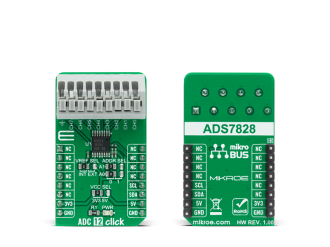
We strongly encourage users to use Package manager for sharing their code on Libstock website, because it boosts your efficiency and leaves the end user with no room for error. [more info]

Rating:
Author: MIKROE
Last Updated: 2020-11-12
Package Version: 1.0.0.0
mikroSDK Library: 1.0.0.0
Category: ADC
Downloaded: 3240 times
Not followed.
License: MIT license
ADC 12 Click is a compact add-on board that contains a fully-featured, general-purpose analog-to-digital converter. This board features the ADS7828, a low-power 12-bit data acquisition device that features a serial I2C interface and an 8-channel multiplexer from Texas Instruments.
Do you want to subscribe in order to receive notifications regarding "ADC12 click" changes.
Do you want to unsubscribe in order to stop receiving notifications regarding "ADC12 click" changes.
Do you want to report abuse regarding "ADC12 click".


Library Description
The library covers all the necessary functions to control ADC 12 Click board™. User can set or read input mode or power-down mode, read raw adc or voltage and send command to input register or read output.
Key functions:
void adc12_send_cmd ( uint8_t cmd_byte ); - Function is used to configure the device.uint16_t adc12_single_ended ( uint8_t chan, uint16_t v_ref ); - Function is used to get raw ADC value.uint16_t adc12_differential ( uint8_t chan, uint16_t v_ref ); - Function is used to get raw ADC value.Examples description
The application is composed of three sections :
void application_task ( )
{
mikrobus_logWrite( "Read Channel 0 raw", _LOG_LINE );
adc_r = adc12_single_ended ( ADC12_SNGL_END_CH0, ADC12_INT_V_REF_VAL );
WordToStr( adc_r, log_txt );
Ltrim( log_txt );
mikrobus_logWrite( "ADC raw: ", _LOG_TEXT );
mikrobus_logWrite( log_txt, _LOG_LINE );
mikrobus_logWrite( "", _LOG_LINE );
mikrobus_logWrite( "Read Channel 0 voltage", _LOG_LINE );
adc_v = adc12_single_ended_volt ( ADC12_SNGL_END_CH0, ADC12_INT_V_REF_VAL );
FloatToStr( adc_v, log_txt );
Ltrim( log_txt );
mikrobus_logWrite( "ADC raw: ", _LOG_TEXT );
mikrobus_logWrite( log_txt, _LOG_TEXT );
mikrobus_logWrite( "mV", _LOG_LINE );
mikrobus_logWrite( "------------------------", _LOG_LINE );
Delay_ms( 1000 );
}
Other mikroE Libraries used in the example:
Additional notes and informations
Depending on the development board you are using, you may need USB UART click, USB UART 2 click or RS232 click to connect to your PC, for development systems with no UART to USB interface available on the board. The terminal available in all MikroElektronika compilers, or any other terminal application of your choice, can be used to read the message.
Library Description
The library covers all the necessary functions to control ADC 12 Click board™. User can set or read input mode or power-down mode, read raw adc or voltage and send command to input register or read output.
Key functions:
void adc12_send_cmd ( uint8_t cmd_byte ); - Function is used to configure the device.uint16_t adc12_single_ended ( uint8_t chan, uint16_t v_ref ); - Function is used to get raw ADC value.uint16_t adc12_differential ( uint8_t chan, uint16_t v_ref ); - Function is used to get raw ADC value.Examples description
The application is composed of three sections :
void application_task ( )
{
mikrobus_logWrite( "Read Channel 0 raw", _LOG_LINE );
adc_r = adc12_single_ended ( ADC12_SNGL_END_CH0, ADC12_INT_V_REF_VAL );
WordToStr( adc_r, log_txt );
Ltrim( log_txt );
mikrobus_logWrite( "ADC raw: ", _LOG_TEXT );
mikrobus_logWrite( log_txt, _LOG_LINE );
mikrobus_logWrite( "", _LOG_LINE );
mikrobus_logWrite( "Read Channel 0 voltage", _LOG_LINE );
adc_v = adc12_single_ended_volt ( ADC12_SNGL_END_CH0, ADC12_INT_V_REF_VAL );
FloatToStr( adc_v, log_txt );
Ltrim( log_txt );
mikrobus_logWrite( "ADC raw: ", _LOG_TEXT );
mikrobus_logWrite( log_txt, _LOG_TEXT );
mikrobus_logWrite( "mV", _LOG_LINE );
mikrobus_logWrite( "------------------------", _LOG_LINE );
Delay_ms( 1000 );
}
Other mikroE Libraries used in the example:
Additional notes and informations
Depending on the development board you are using, you may need USB UART click, USB UART 2 click or RS232 click to connect to your PC, for development systems with no UART to USB interface available on the board. The terminal available in all MikroElektronika compilers, or any other terminal application of your choice, can be used to read the message.